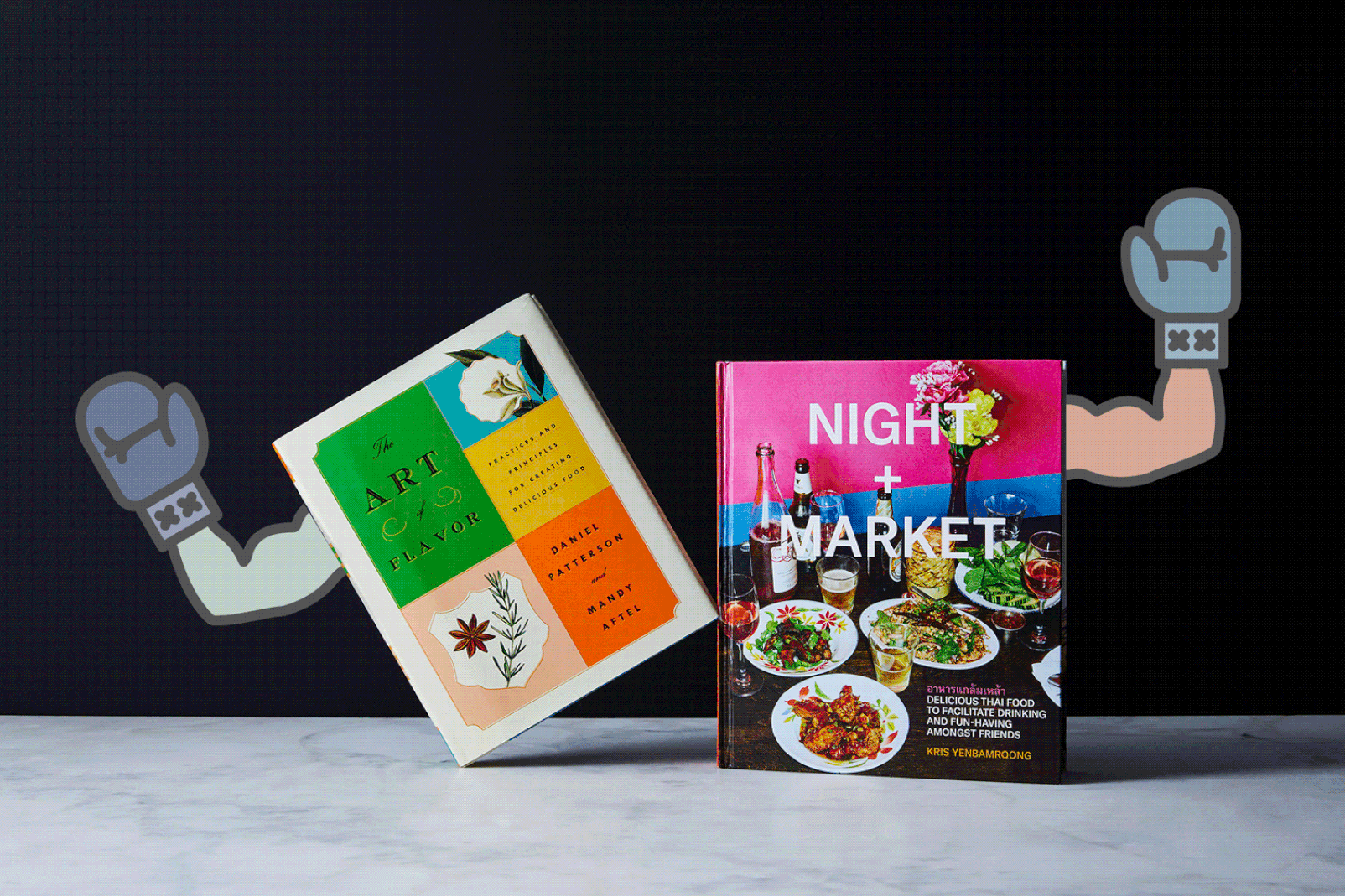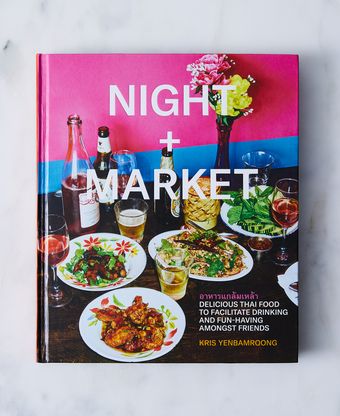Is there a purer expression of art than food? Is there any other art form that not only stimulates every single sense but also can transport you to a place or even a time that you hold dear? When I ate my way through these two cookbooks, I was reminded that food has that magical ability to capture moments and memories. While both books yielded unbelievably delicious food and proved a joy to cook through, for me, art comes down to the feeling that you get when you experience it and one of these books truly warmed my heart.
Now, let’s not sugarcoat it. This ended up being quite the daunting task, considering I decided to make a weekend out of cooking and rating both. The Art of Flavor would get Friday night and Night + Market would take on Saturday night. (And Sunday would be a day for rest and stretchy pants.)

First up: The Art of Flavor. Chef Daniel Patterson is undoubtedly a food visionary and someone I deeply respect, especially for his unbelievably progressive work with LocoL. Perfumer Mandy Aftel is not only a gifted writer, but also has to have one of the greatest palates (and noses) in the world. Each one has a deep knowledge of flavor and years of experience working with it; put them together and they meet at “the intersection of scent and taste,” as they call it. The result is a beautiful, albeit ambitious cookbook that isn’t just a collection of recipes (although there are over 75), but an attempt to identify the principles “that govern how flavor is composed.” These are principles that any home cook can and should follow, and the recipes are teachable moments that bring them to life. Ultimately, Patterson and Aftel want you to become a creative, confident cook who can work with every ingredient to make delicious, memorable food. All this, and they do it without pictures. It’s a big undertaking, but you figure if anyone can pull it off, it’s these two.
I decided to take on a 3-course meal from The Art of Flavor. A simple affair consisting of Medjool Dates Baked with Bacon and Gorgonzola Dolce, Seared Scallops with Butter and Lemon, and Braised Beef with Black Tea and Orange. You know, a typical Friday meal in the Prinze household.
The first dish—Medjool Dates Baked with Bacon and Gorgonzola—is used to illustrate the second of their four rules: “Contrasting ingredients need a unifying flavor.” I adore dates so this recipe immediately caught my eye. I loved the mild creaminess of the gorgonzola dolce paired with smoky bacon. But more than how great it tasted, I appreciated learning why it works: the fruit is the unifying flavor—it holds the other two in balance.
On to the scallops. This is the example given to teach you how to sear food properly, here with the simple but genius tip to wait to add butter until you flip so the fat doesn’t burn as the scallops sear on the first side. With a squeeze of lemon, these scallops did not last long at all.
And for the main course, the braised beef. We don’t do a ton of braising, but the black tea in the ingredient list intrigued me, so I decided to give it a go. This recipe is supposed to demonstrate “locking”, or what Aftel and Patterson explain as what happens when ingredients combine to be more than the sum of their parts. The final dish was amazing, the mix of the black tea and orange with the beef truly inspiring. I’m telling you, this needs to be on your holiday menu next year.

Overall, a pretty stellar meal. As an avid baker and someone who is constantly chasing new tastes, I can appreciate their pursuit of perfect flavors. Reading this cookbook definitely helped me think about how I can use these rules in all of my recipes moving forward.
Next up: Night + Market. Disclaimer: I have never made traditional Thai food in my life. Something else you should know: This is not a cookbook. It is a coffee table book. Marcus Nilsson’s photos are raw, stunning, and instantly whet the appetite. My menu for the night felt like a huge undertaking: Marinated Thai Tomatoes, Thai Dim Sum, and Thai Boxing Chicken (Gai yang sanam muay) with fried rice. But the beautiful thing about Night + Market is it makes the fundamentals of Thai cuisine achievable. No easy feat (for me)!
Marinated tomatoes seemed like a good start. The full title of this recipe is very long because it is not just a recipe: Marinated Tomatoes (And a Lesson in Balancing Thai Flavors). The fish sauce, chiles, and sesame seeds took a California classic tomato salad and cranked up the intrigue and deliciousness to 10. It works based on the “square” principles of dressing. Yenbamroong imagines Thai salad dressing with four sides—lime, sugar, chile/garlic and fish sauce. If the main ingredient the sauce enhances is bland, you’d have those four components in equal measure (see, 4 equal sides, like a square!). But you need to alter the ratio when that main ingredient is more powerful—like tomatoes, which have quite a bit of sugar and acid. You don’t really need the lime or sugar anymore. I definitely learned a lesson—in geometry and seasoning—and couldn’t help but think Aftel and Patterson would approve of this combination of flavors.
Next up was Thai dim sum (khanom jeeb). They’re based on dumplings Yenbamroong’s grandmother used to make. They’re filled with quite the mix: ground pork, crabmeat, jicama, egg, and a Garlic-Cilantro Paste that’s worth the minimal effort of putting cilantro stems and garlic in a blender with salt and pepper. While most cookbooks give you one photo of the finished dish, Night + Market walked me through the entire process visually. I wouldn’t say I’ve mastered these yet, but as Yenbamroong guided me through each step, the cuisine felt much more approachable.
The Thai Boxing Chicken roped me in with its name, but the tender flavors will have me coming back for more. For a dish so simple (all I basically had to do was marinate and grill it), I couldn’t believe how good it was. The poultry really gets its power from the marinade, which is cooked and includes more of the Garlic-Cilantro Paste that went into the dumpling filling. I can almost imagine going to a Muay Thai fight in Bangkok, coming out all pumped up, and ecstatically tearing into this chicken with other fans.

It wasn’t until after my three-course Thai meal that I realized it wasn’t just the food that resonated, but the story too. Yenbamroong writes about his dad’s Thai restaurant Talésai, which he opened in the 1980s and is next door to that original Night + Market on Sunset Boulevard. When I first moved to Los Angeles, it was one of my favorite places to eat in the city.
I fell in love with Night + Market quickly. It’s a dance through a personalized version of Thai cuisine and the photos are authentic, warm, and inviting. The recipes absolutely delivered and, better yet, empowered me to step outside my comfort zone. But the best thing about this book is the way its food made me and my family feel. As we sat down and ate, the moment felt livelier, the flavors more exciting, and the memories unforgettable. In this battle of artistic geniuses, only one cookbook has the word “Art” in its title, but it’s not the one that made me feel something on a deeper level. That’s what places Night + Market a notch above The Art of Flavor.



12 Comments
And I agree that the judgements have been on point this year, with people who have actually cooked from the books they were given! Thank you Sarah!